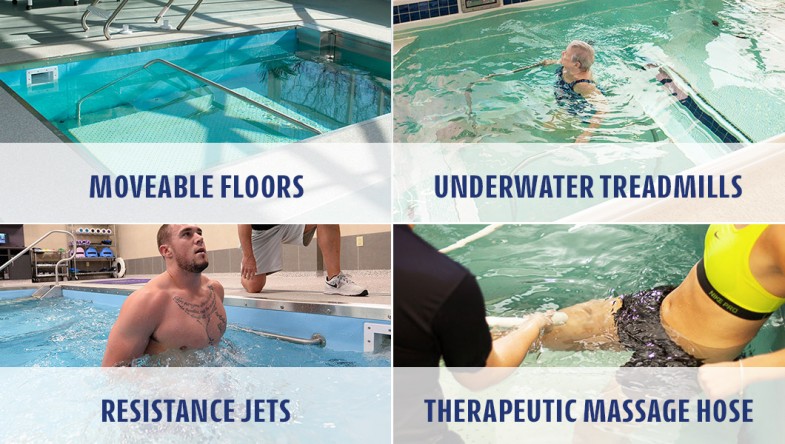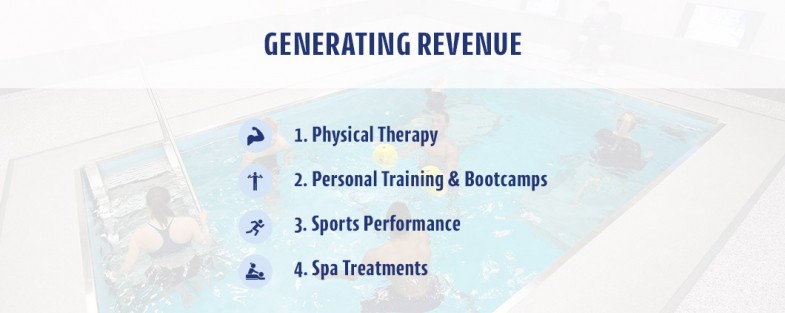Making Waves: How to Start an Aquatic Therapy Program

But the benefits of aquatic therapy don’t come without some preparation, and starting an aquatic therapy program at your clinic means there is plenty to consider. Fortunately, we’ve made the process as simple as possible.
Request a Free Info Kit View Our Products Find a Pool Near You
Why Begin an Aquatic Therapy Practice?
Over the past couple of decades, a tremendous amount of research has emerged to support the effectiveness of aquatic therapy as a way to treat orthopedic injuries, musculoskeletal, neuromuscular and cardiopulmonary disorders. It’s also a fantastic way to improve functional abilities, like balance and walking, in the wake of debilitating illnesses or major surgical procedures. In particular, studies have shown aquatics to be highly effective at improving post-operative mobility and endurance.
A growing number of physical therapy clinics are now turning to aquatics. As far back as 2005, Medicare spending on aquatic therapy reached $46 million, and the numbers continue to rise.
The range of candidates for aquatic therapy intervention is vast. Injured athletes, seniors with arthritis, individuals recovering from strokes, those recovering from major surgery and those that are low-functioning are just some of the wide variety of patients that can benefit from aquatic therapy.
Make no mistake: Implementing aquatic therapy will change how your clinic operates. And the benefits are quite real:



Although your long-term treatment plans will likely involve more traditional land-based therapy, aquatics can be a fantastic stepping-stone to improve early mobilization.
What Will It Cost?
No doubt this is one of the first questions on your mind. Naturally, every organization is different, and there are many factors that will influence the answer. Here are a couple of the major expense categories you’ll need to keep in mind as you research your options:
Staff and Training
As an administrator, you’ll need to consider whether to train your current staff members in aquatic therapy techniques, hire additional clinicians, or both. If your facility hasn’t offered this service in the past, it’s likely your physical therapists have received very little aquatics training. This is not a core course in the required curriculum of most therapeutic programs. As a result, few students get much, if any, exposure during their formal studies or clinical rotations. It is important to train staff on all aspects of aquatic therapy including scheduling and therapy protocols in order to increase compliance and outcomes.
Spending time understanding the best staffing scenario for your facility is important. In addition, finding ways to turn your clinicians into aquatic therapy champions through additional training and education should be a priority leading up to the installation of your pool. The more your staff embraces aquatic therapy, the more successful the program will be.
Ultimately, having at least one aquatics advocate on staff can help to make your aquatic therapy program extremely successful. This person is often responsible for encouraging patients to try the pool, informing referring physicians of the benefits and helping staff to understand the advantages of aquatic therapy.
Facilities and Equipment
Of course, staff members won’t be your only expense. You’ll also need a pool or pools and peripheral apparatuses, dependent on your expected therapeutic needs. Successful aquatic therapy depends on the quality and ability of your equipment just as much as it does on the human guidance factor.
Today’s therapy pools are often quite advanced and may feature integrated equipment including but not limited to:
- Moveable floors, zero-depth entry (or variable water depth)
- Underwater treadmills
- Resistance jets
- Therapeutic massage hose
- Diagnostic camera systems
- Computer monitoring and recording systems
Pools may range in scale from large lap pools of a dozen or more feet in length down to smaller tanks that are sized with the individual in mind, such as the HydroWorx 300. This is the most important part of the therapeutic puzzle, so be sure to think long and hard about what you’ll need to get out of your pool.
As you continue to research your options, be sure to consult with your financial advisors, accountants and/or investors. This will help to give you a better understanding of your available budget, which is crucial to develop before you begin to shop around.
Once you’ve got your finances in order, you can begin to explore different pools based on the needs of your current, and anticipated, clientele. And don’t forget to include your utility bill in your price considerations: the costs of pumping and heating water, as well as the electricity you’ll need to light and maintain the area, are simple facts of pool ownership.
Remember, when you make aquatic therapy available, the benefits for your business extend beyond mere extra billing opportunities for existing patients. Offering this invaluable service means you can expect to receive a number of additional physician referrals and increase your visibility to a greater range of potential clients. In particular, aquatics can often be a more comfortable environment for older individuals and those with chronic pain, who may shy away from other rehabilitation methods.
Starting an aquatic therapy program of any scale does require a certain investment, but the subsequent revenue stream, and, more importantly, the rehabilitative results for your patients are more than worth it. Use our ROI Calculator to determine your potential return on investment>>
Developing an Aquatic Therapy Program
With all the major tools in place, all that’s left is to work out the specifics of an effective aquatics program for use in your clinic. If you’ve enlisted the services of that functional design consultant mentioned in the last section, they should be able to assist as you draw up a new business plan.
There are many steps that go into planning an aquatic therapy program, but they can be largely condensed into the following:
- Define your overall goals. What do you hope to offer patients? What kind of growth do you want to achieve?
- Describe your target patient. What is their background? Why do they seek physical therapy?
- Identify the potential referring sources in your area.
- Identify the strengths and weaknesses of your competition, particularly those in close proximity. What could you do that they currently don’t? And what can you do better than them?
- Work with experienced aquatic physical therapists to determine how best to meet your anticipated needs.
- Draw up marketing proposals. When you’re adding a completely new service, people need to be informed.
Think about your most frequently seen patients: What sorts of treatment do you already offer them, and how could they benefit from aquatics? This is a great place to start when developing your therapy curriculum.
Of course, aquatic therapy does provide a great opportunity to branch out in terms of services offered. You may also wish to offer brand-new services that could appeal to certain patients who you don’t currently attract — those with disabilities that make therapy on land difficult or unsafe, for instance.
As you continue to prepare, one question may arise: How will adding aquatic therapy change your billing model? Unfortunately, there’s no simple answer, as this is going to be very different for each clinic. Most clinics will bill aquatic therapy under 97113, but do note that each state has different reimbursement rates and regulations regarding aquatic therapy.
Common Missteps and How to Avoid Them
Aquatic therapy is a fantastic service, but it’s also a considerable investment. Even the best-case mistakes, such as buying equipment that you won’t use, can be quite expensive. Worst-case scenarios, such as building a pool that’s just too small, can be catastrophic. Fortunately, you can learn from the errors of others and avoid these common missteps.
Plan Before You Build
It’s been mentioned before that thinking about your therapy plan before designing your facilities is critical, but it really does bear repeating. The biggest mistake any physical therapy clinic can make is to invest in equipment before understanding how it will all be used. And if you don’t effectively predict demand, you may well end up with an undersized facility. You certainly don’t want to find yourself turning away patients due to a lack of space, especially within just a year or two of opening up.
Many clinics have simply selected a traditional-looking, multi-use pool in the very beginning stages, and only then considered how their aquatic therapy offerings would function. This certainly can work in your favor, if only by chance, but it’s far from the best way to go. Instead, draw up a rough proposal that includes a list of every patient service that you anticipate requiring.
If a piece of equipment doesn’t fit into your plans, don’t buy it. Likewise, when budget crunches occur, be sure you do note which items you cannot compromise on.
Get a Handle on HVAC
Pools make for a very unique work environment, especially indoor ones. They are often kept warmer than standard rooms and will add considerably to the airborne humidity levels. If yours lacks effective HVAC and dehumidification systems, it can be a very unpleasant and unhealthy space in which to spend extended periods of time. This is a new concept for most business owners, and you may not even know where to begin with addressing it. Attentive pool room design, a service provided by some pool vendors, can help you easily avoid common HVAC issues.
Use Commercial-Grade Equipment
When it comes to choosing supply pumps, filters, lights, and other essential equipment, managers may be tempted to go with the cheaper items that are marketed toward residential pools. After all, your therapy pool is much smaller than most municipal facilities, so shouldn’t this be sufficient?
In fact, commercial therapy pools are very similar to public pools, at least in terms of wear and tear. They’re generally used much more heavily than their residential counterparts, and this places extreme demands on your gear. Equipment winds up being much more expensive when you need to repair or replace it constantly, and that’s not to mention the lost revenue and reputation you’ll face when the pool is out of service. Invest in commercial-grade supplies. You’ll be glad you did.
Get Started With Aquatic Therapy Today
Ready to grow your business while simultaneously helping your clients achieve their therapy goals? It’s even easier than you think. Request your free “Getting Started Kit” from HydroWorx today. We’ll give you the tools you need to shape and develop your aquatic therapy business plan and step-by-step guidance to lead you along the way.
And when the time comes to select a pool, don’t forget HydroWorx offers a number of solutions to cover every need. With convenient and affordable financing options, you can get your own project started for under $400, and with credit approval in just hours.
An aquatic program is an essential part of physical rehabilitation. It fills a unique niche that can’t otherwise be replicated and will differentiate you from your competition. Adding aquatic therapy to your repertoire is the right choice for your patients and for your clinic.
Request a Free Info Kit View Our Products Find a Pool Near You
Page Updated on: July 7, 2020





I really want to improve my clinic with aquatic therapy.
We’d be happy to discuss it with you! We can have our international representative reach out.
I’m just pondering the idea as my family has and will need this type therapy. I’m interested in offering swimming lessons and water safety as well. I am a designer by trade and have no type physical therapy education. I live in a rural area but have. APhysical therapy business just down the road.. would it be possible to offer to them as a service two or three times a week..